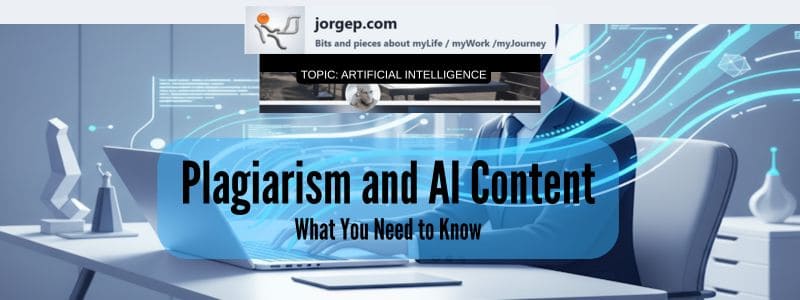Plagiarism and AI Content Generation: What You Need to Know

Part of: AI Learning Series Here
Quick Links: Resources for Learning AI | Keep up with AI | List of AI Tools
Subscribe to JorgeTechBits newsletter
Note: Written with the help of my research team 🙂 including: (Google Gemini, Google Notebook LM, Microsoft Copilot, Perplexity.ai, Claude.ai and others as needed)
Artificial intelligence has transformed how content is created. Whether blogging, preparing academic essays, compiling business reports, or launching marketing campaigns, AI tools like ChatGPT make writing faster and easier. However, this convenience raises a crucial question: What happens when AI and plagiarism intersect?
What Is Plagiarism?
Plagiarism is using someone else’s words, ideas, or creative work without proper credit. It includes direct copying, rephrasing without acknowledgment, or presenting someone else’s concepts as original. The boundaries get especially blurry when AI is involved, as it can unintentionally echo existing works.
According to the [Modern Language Association (MLA)], [American Psychological Association (APA)], and major universities, plagiarism policies apply regardless of whether a person or an AI tool generated the content.
How AI and Plagiarism Overlap
- Direct Text Overlap: AI tools can produce text closely resembling published materials, sometimes word-for-word.
- Paraphrased Without Credit: When AI rewords existing content and sources aren’t credited, it’s still considered plagiarism under [most institutional guidelines].
- Idea Theft: Conveying another person’s original idea as your own (even if reworded) is plagiarism, per major style guides.
- Images, Code, and Media: AI now creates art, code, and music. Use of content that closely imitates or copies protected works without attribution can be both plagiarism and copyright infringement, subject to different rules depending on national laws and publisher policies.
The Limits of Plagiarism Detection Technology
Most plagiarism detection tools—like Turnitin, iThenticate, and Grammarly—focus on matching text to existing publications. However, advanced AI-generated paraphrasing or hybrid content (mixing original and generated text) can evade these detectors. Some AI output may appear original to scanning algorithms even if it closely resembles ideas or structure from an existing work. The [International Center for Academic Integrity (ICAI)] emphasizes that human review remains essential.
Can You Be Sued or Disciplined for AI Plagiarism?
Yes—and precedent is emerging. While you can’t sue an AI, individuals and organizations bear responsibility for submitting or publishing plagiarized content.
- Academic/Professional Consequences: Universities and employers are increasingly explicit: if work is flagged as plagiarized—even by AI—it may be rejected or penalized. [Recent academic statements from Cambridge, MIT, and Stanford clarify this expectation].
- Legal Consequences: Copyright holders can sue if AI-generated material reproduces substantial protected content. In 2023 and 2024, several lawsuits (notably against OpenAI and Meta) highlighted the legal risks when AI-generated text or images closely mimic the original expressions of published works. Laws continue to evolve, making it vital to stay informed about the latest guidance from academic and professional bodies.
How to Protect Yourself
- Run Plagiarism Checks: Use detection tools, but recognize their limits—manual review is still needed, especially for nuanced cases.
- Cite Sources: If AI outputs a fact, statistic, or passage from a known source, cite the original—not just the AI. Follow institutional guidance on citation.
- Be Transparent: Disclose AI use when required. Many academic journals, publishers, and schools (including Nature, Elsevier, and the MLA) now expect this.
- Use AI as a Drafting Tool: Treat AI output as a first draft. Integrate your own insights, critical analysis, and unique voice before submitting.
- Understand Fair Use: Limited quotations with analysis may be allowed (U.S. “fair use”), but copying substantial content isn’t.
- Keep Detailed Records: Save drafts, prompts, and research notes to verify how your work was created.
- Check Copyright Policies for Commercial Use: Prefer AI tools like Adobe Firefly which offer clear copyright guidelines, and heavily edit drafts before release.
Example Disclaimer
When appropriate, add a note such as:
“This content was drafted or assisted by AI tools and then reviewed, edited, and finalized by the author in accordance with [institution/publication] guidelines.”
Final Thoughts
AI is a remarkable tool for productivity, but users retain full responsibility for ensuring originality and proper attribution. Consult the latest policies from academic, legal, and publisher authorities. Remember: transparency, diligence, and human oversight are key to ethical content creation in the AI age
See also my previous post: Do You Own That AI-Generated Content? Think Again
References and Further Reading
- Modern Language Association (MLA) Plagiarism Guidelines
- American Psychological Association (APA) Ethics & Plagiarism
- International Center for Academic Integrity (ICAI)
- Turnitin Plagiarism Detection Technology
- Cambridge University Statement on AI & Academic Integrity
- MIT Guidance on Generative AI and Originality
- Stanford University AI Policy
- Nature Journal Policy on AI Content
- Elsevier Publishing AI Disclosure Policy
- Adobe Firefly Copyright & Usage Guidelines
- Recent AI Copyright Litigation News
